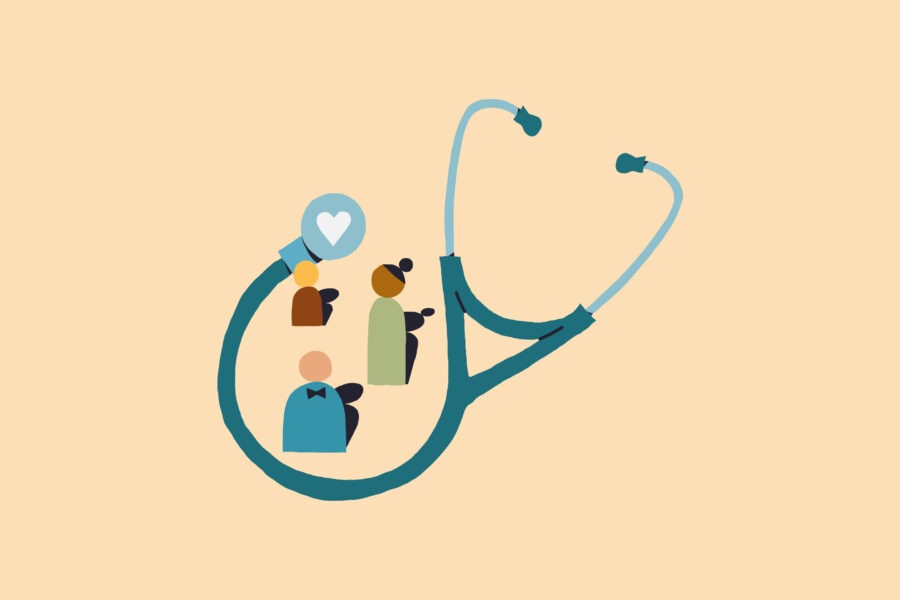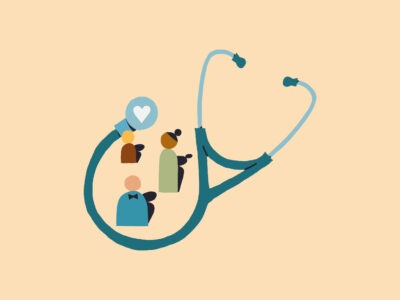Solving homelessness is possible. And one critical step towards achieving a healthier, more equitable reality where homelessness is rare and brief requires understanding that solving homelessness is not the job of a single sector. It is the work of a whole community.
As a powerful part of that community, health systems have a transformative and catalytic role to play. Health systems committed to advancing and upholding the overall health of their communities have embraced an “anchor” mission. This concept recognizes that as institutions with roots in communities, health systems can hold a vision for long-term success, which can both withstand and outlast short-term political concerns.
While collaboration between health care and homeless response systems is increasingly recognized as a key strategy for improving health and housing outcomes for the unhoused population, learnings are still emerging on the most transformative and measurable contributions health care can make.
One of the most catalytic steps toward unlocking the full potential of this collaboration is the ability to share a real-time, person-centered line of sight into a community’s unhoused population. Without this shared data, it is difficult for the health and homeless response systems to coordinate care for individuals and to drive the systems-level changes that can improve housing and health outcomes at the population level.
We heard and witnessed the many challenges that stand in the way of facilitating this critical data-sharing between systems. Challenges include privacy concerns when sharing information about individuals, hesitation from hospital legal teams to sign off on data-sharing due to HIPAA, difficulty matching collected information between two distinct systems, capacity to pull data on a regular basis, and data quality limitations. Despite these challenges, major health and homeless systems have proven that these barriers are not insurmountable, and that it is possible to establish and harness this bi-directional data.
This learning brief will focus on two communities that are participating in a three-year pilot initiative operated by Community Solutions and the Institute for Healthcare Improvement. It will detail how data-sharing has been facilitated in Sacramento, California between four major health systems (CommonSpirit Dignity Health, Kaiser Permanente, UC Davis, and Sutter Health) and Sacramento Steps Forward, the Continuum of Care lead, and in Washington County between Kaiser Permanente, Providence Health, and Washington County Department of Housing Services, the Continuum of Care lead.
Why Data-Sharing Matters
A critical component of a community’s ability to end homelessness is having an understanding of who is experiencing homelessness at any given time, how that number is changing month over month, and other population-level dynamics, like inflow and outflow from homelessness.
Homeless response systems across the country have worked to develop this standard of quality data, also referred to as by-name data. This data source ensures that every person in a community experiencing homelessness is known by name, in real time. Using information collected and shared with their consent, each person on the list has a file that includes their name, homeless history, health, and housing needs.
Partnerships between the health and homelessness systems can ensure that this data is comprehensive and that all unhoused neighbors are accounted for. Hospitals have been able to alert the homeless response system of patients that are experiencing homelessness who were previously unknown to the homeless response system. When a client becomes known to the homeless response system, the constellation of service providers within the Continuum of Care (CoC) can connect this person with services and support the process of them accessing and moving into safe, affordable, and stable housing.
Data-sharing between these two systems can also help both systems improve the health outcomes and care for people experiencing homelessness. This data enables them to understand the health outcomes for people who are experiencing homelessness, track progress towards better outcomes, and ensure people are accessing health care. Data-sharing between homeless response systems and health systems can lead to cross-sector case conferencing that brings expertise and resources from both systems around the same table. These conversations can lead to health system staff providing health care for people experiencing homelessness that can be critical for meeting their needs. Additionally, providing health care to people experiencing homelessness can help rebuild their trust with a health care system and connect them to primary care and other supports that will further enable their retention in housing.
Health system involvement in patient care for people experiencing homelessness can also improve housing outcomes. The housing process can be complex, time consuming, and filled with false starts, which can lead people experiencing homelessness to lose trust and faith with the homeless response system. When there are health care providers that are continuously showing up and delivering services to meet people’s physical health needs along the way, this can sustain trust between providers and people experiencing homelessness. This sustained trust serves to keep people engaged in the housing process despite potential frustrations, resulting in better housing outcomes as well.
In some communities, hospitals have embedded housing navigators within emergency departments to expedite referrals into coordinated entry for post-discharge housing placements, as well as to longer-term housing supports funded by federal Medicaid dollars (for example, the new Medi-Cal waiver in California).
Data-sharing can improve the process of discharging people experiencing homelessness from a hospital. We all recognize that it is morally and ethically bereft to release people experiencing homelessness from the hospital to the street. Sharing by-name data between health systems and homeless response systems enables care coordination to improve discharge planning. With increased knowledge and awareness of the services available from the homeless response system, as well as partnerships with local homeless providers, health care providers can begin to coordinate care for people who are released from a hospital while experiencing homelessness in a more humane and ethical manner.
Sacramento, California
Dignity Health/CommonSpirit, Kaiser Permanente, UC Davis Health, and Sutter Health are the four health systems in Sacramento County that manage area hospitals which see high volumes of homeless patients. Through the national Healthcare x Homelessness Pilot Project, these four systems have been working with Sacramento Steps Forward, the county’s Continuum of Care lead agency, to create a more seamless integration between the local health system and homeless response system in order to improve long-term outcomes of homeless patients.
Each health system is developing a separate data-sharing agreement with Sacramento Steps Forward, whereby the health systems can access by-name data, coordinate care for people in their community experiencing homelessness, and share aggregated health data back to the homeless response system.
“We prioritized data-sharing as one of our main focus projects, recognizing that being able to share this information across systems is the first step to coordinating an individual’s care,” said Brian Heller de Leon, Community Health Manager for Kaiser Permanente in Greater Sacramento. “ Through data-sharing and leveraging hospital-based health and housing navigators, the coordination of care with community-based service providers can begin even before patients are discharged from the hospital setting.”
Because HMIS (Homeless Management Information System) data is ultimately under the federal oversight of the department of Housing and Urban Development (HUD), the data-sharing agreements with Sacramento Steps Forward had to adhere to strictly templated language that covered use agreements, robust data protections, and indemnifications. The four health systems underwent a long journey with their legal and compliance teams to review the templated language, assess for risk, and provide final edits that could address the data-sharing needs of both systems.
The new data-sharing agreements mean that:
- Each hospital system will be able to cross reference their patients with the by-name data.
- The health systems’ Electronic Health Records (EHR) systems and the Homeless Management Information System (HMIS) will track similar data points to ensure ease when cross-referencing patients.
- Navigators working within each of these hospitals will have access to HMIS to refer patients into coordinated entry before discharge, and to track longer-term housing outcomes for patients experiencing homelessness.
These data-sharing agreements will also enable the hospital systems to track aggregate health outcomes for people experiencing homelessness. These insights will be used to understand the health needs of people experiencing homelessness, and engage in discharge planning for this population as they leave hospitals. It will also allow hospitals to identify people who are not yet in the by-name data who need to be connected to the services and supports that exist within the homeless response system.
Washington County, Oregon
In Washington County, Kaiser Permanente, Providence Health, and the county have worked to enter into data-sharing agreements between each health system and the Continuum of Care.
“Kaiser Permanente Northwest is proud to partner with Washington County on this innovative project to build cross-sector relationships and better support our unhoused patients,” said Dr. Briar Ertz-Berger, Medical Director for Social Health and Quality Management. “This collaboration gets us out of our system silos by enabling us to speak directly with the homeless response system and coordinate care for some of our most vulnerable members.”
The initiative began with a small pilot project when the county worked with the health and homeless systems to exchange data in order to address the needs of individuals in the local winter shelter. Witnessing the value of this pilot, which was facilitated through their case conferencing practice, the partners decided to pursue more formal agreements. Since then, the partners have scaled a process that includes more individuals experiencing homelessness and additional partners within their community.
These agreements are unidirectional, which means that health systems receive lists of unhoused people from the Homeless Management Information Systems (HMIS). Healthcare partners use this information to assess if people experiencing homelessness are patients of their health systems and work to address their unmet medical needs. During a routine meeting known as case conferencing, health care coordinators and housing case managers review the housing and health status of individuals on the list and collaborate to close gaps in care, whether that is by connecting people to primary care or coordinating care post-hospital discharge. These meetings also strengthen communication between health and housing teams, which can include, for example, ensuring housing case managers have contact info for the right care team within the health system.
Washington County will use the data shared between the CoC and the healthcare systems to enhance cross-sector case conferencing practices, improve discharge planning from hospitals for people who are experiencing homelessness, and enable the county to better understand the health needs of people experiencing homelessness.
“This work is core to meeting the needs of our patients and communities,” said Megan McAninch-Jones, Executive Director of Community Health at Providence. “We know that a lack of stable housing impacts health outcomes, and we may be the first point of care where an individual identifies themselves as experiencing homelessness. By working together, we can provide more robust, coordinated, and person-centered care to meet the individual’s needs.”
The long-term aim is to build additional partnerships with the health care sector to meet the needs of people experiencing homelessness in the county. For example, Health Share of Oregon, a coordinated care organization (CCO) that serves Oregon Health Plan (Medicaid) members in Clackamas, Multnomah, and Washington counties, has been engaged to join the data sharing agreement and help manage the data workflow. Additionally, a data sharing agreement is close to being executed with CareOregon, the entity responsible for managing the behavioral health benefit for Medicaid members in the area. Engaging additional partners across the community through data-sharing agreements allows for improved tracking of service connections, referrals, and other outcomes for this vulnerable population.
“The Homeless Services Division is excited to engage health system partners like Health Share and CareOregon in our Healthcare Case Conferencing work because of their unique positionality and expertise as entities that manage the physical and behavioral health benefit for so many Medicaid members in the Portland Metro Region,” said Allie Alexander Sheridan, Program Coordinator at Washington County Health and Human Services.
“Their ability to work across health plans and systems will streamline our efforts to identify opportunities for community members experiencing homelessness to get connected to the health care they need and engage the right health care partners in our efforts to provide whole person care.”
Recommendations and Resources
Navigating data-sharing between two sectors can be complex, so we have developed a Data-Sharing Toolkit that can be used to support your journey towards data-sharing between systems. The Data-Sharing Toolkit illustrates a spectrum of data-sharing options, from aggregate level sharing to bidirectional, person-specific data-sharing, and everything in between. Both Washington County and Sacramento have taken different approaches to data-sharing that helped realize the goals of their local system. Understanding the many barriers that exist for data-sharing between systems, the Data-Sharing Toolkit encourages a community to start small and sees the process as incremental and scalable.
We also asked partners to reflect on their experience working to execute data-sharing agreements between the homeless response system and health care systems. Sites gave the following guidance to other communities looking to approach data-sharing between sectors:
- Be patient as you embark on this journey, and work to “shrink the change” by starting with small steps that will lead to your ultimate goal.
- No matter how well you plan for this work, you should be prepared to pivot your plan as necessary. Things will come up that you haven’t thought of before!
- Add more time to your project timeline. It’s a lengthy process, and it is good to be realistic about this.
- Build relationships with the people that you are working with on a data-sharing project. Relationships are critical, and the technology and data will follow from these relationships.
- Consider what’s feasible and be intentional about why you are seeking to share data and the impact it will have on clients/patients and systems change.
- Be clear and judicious about what you are asking the data teams to pull, when you are asking them to do it, and why you are asking them to do it so that you aren’t asking people to pull data just for data’s sake.




